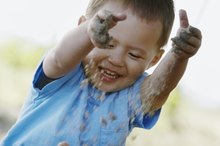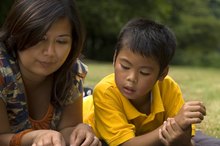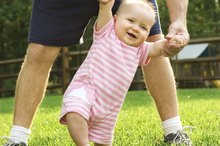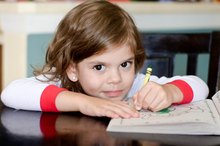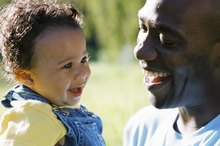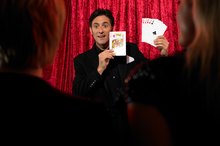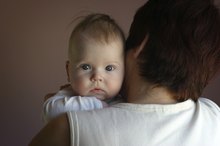How Can Parents Help in the Sensorimotor Stage?
Psychologist Jean Piaget described four stages of cognitive development that children go through on their way to becoming adults. The first stage is the sensorimotor stage. Children experience this stage from birth to age 2, according to the authors of the Department of Educational Psychology and Instructional Technology at the University of Georgia's "Piaget's Stages" website. Parents can become actively involved in helping their children master the goals of the sensorimotor stage.
Sensorimotor Stage
During the sensorimotor stage, infants are developing their motor skills. They do not have the ability to predict cause and effect yet, so they experiment with movement to learn what the results of their actions. For example, the baby may throw a ball but he does not have an understanding of what happens once he throws it. Memory develops around 7 to 9 months of age, and babies begin to realize that objects do not disappear once they are hidden.
- During the sensorimotor stage, infants are developing their motor skills.
- Memory develops around 7 to 9 months of age, and babies begin to realize that objects do not disappear once they are hidden.
Sensory Discrimination
Early Childhood Perceptual Development
Learn More
One skill that babies learn during the sensorimotor stage is "sensory discrimination." Sensory discrimination is the ability to distinguish between two sensory experiences. Parents can help develop this sense by exposing their infant to two sensations at the same time, or by introducing him to one experience directly after the other. Examples of activities that may help develop sensory discrimination are giving the baby a cold object to handle, such as:
- a cool
- wet washcloth,
- then giving the baby a warm
- wet washcloth immediately afterward
Letting the baby feel objects with different textures is another helpful activity.
- One skill that babies learn during the sensorimotor stage is "sensory discrimination."
- Parents can help develop this sense by exposing their infant to two sensations at the same time, or by introducing him to one experience directly after the other.
Object Differentiation
Babies also learn about "object differentiation" in this phase, which means that they learn about how objects are similar and different. For example, they learn to distinguish between toys by color, size, shape and other sensory details. Parents can help babies learn object differentiation by showing them two toys that are similar but have a fundamental difference like color or size. Place the objects no more than 6 inches from the baby's face so that she can see them clearly and grab them.
- Babies also learn about "object differentiation" in this phase, which means that they learn about how objects are similar and different.
- For example, they learn to distinguish between toys by color, size, shape and other sensory details.
Motor Skills
Visual Perception Problems in Children
Learn More
Children in the sensorimotor stage are developing their motor skills. While it is tempting to keep your infant swaddled for her comfort, she needs to experience unrestricted movement, according to Nanolla Yazdani, Ph.D., author of "Promoting Creativity in Childhood." Place your infant on a play mat on the floor in a safe location where she can't fall or encounter hazardous objects 1. Let her move her limbs and roll over or crawl, if she is old enough to do so. This activity helps her learn about movement and controlling her body.
- Children in the sensorimotor stage are developing their motor skills.
- While it is tempting to keep your infant swaddled for her comfort, she needs to experience unrestricted movement, according to Nanolla Yazdani, Ph.D., author of "Promoting Creativity in Childhood."
Related Articles
References
- Promoting Creativity in Childhood; Nanolla Yazdani, Ph.D.
- Tess Lefmann & Terri Combs-Orme (2013). Early Brain Development for Social Work Practice: Integrating Neuroscience with Piaget's Theory of Cognitive Development. Journal of Human Behavior in the Social Environment, 23:5, 640-647. doi:10.1080/10911359.2013.775936
- Piaget, J. (1977). Gruber, H.E.; Voneche, J.J. eds. The Essential Piaget. New York: Basic Books.
- Piaget, J. (1983). Piaget's Theory. In P. Mussen (ed). Handbook of Child Psychology. 4th edition. Vol. 1. New York: Wiley.
- Santrock, John W. (2008). A Topical Approach to Life-Span Development (4 ed.). New York City: McGraw-Hill.
Writer Bio
Natalie Smith is a technical writing professor specializing in medical writing localization and food writing. Her work has been published in technical journals, on several prominent cooking and nutrition websites, as well as books and conference proceedings. Smith has won two international research awards for her scholarship in intercultural medical writing, and holds a PhD in technical communication and rhetoric.
